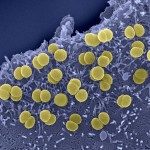Link to Pubmed [PMID] – 10698947
EMBO J. 2000 Mar;19(5):1068-78
PilC1, a pilus-associated protein in Neisseria menin- gitidis, is a key element in initial meningococcal adhesion to target cells. A promoter element (CREN, contact regulatory element of Neisseria) is responsible for the transient induction of this gene upon cell contact. crgA (contact-regulated gene A) encodes a transcriptional regulator whose expression is also induced upon cell contact from a promoter region similar to the CREN of pilC1. CrgA shows significant sequence homologies to LysR-type transcriptional regulators. Its inactivation in meningococci provokes a dramatic reduction in bacterial adhesion to epithelial cells. Moreover, this mutant is unable to undergo intimate adhesion to epithelial cells or to provoke effacing of microvilli on infected cells. Purified CrgA is able to bind to pilC1 and crgA promoters, and CrgA seems to repress the expression of pilC1 and crgA. Our results support a dynamic model of bacteria-cell interaction involving a network of regulators acting in cascade. CrgA could be an intermediate regulator in such a network.

